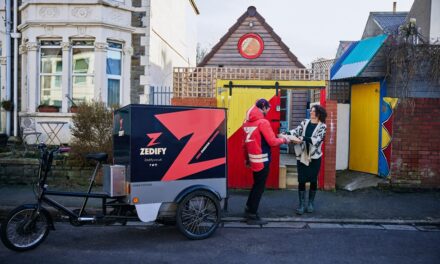
Nestlé Purina: There is no planet B: we have to improve ours

Alexsandro Andrade Silva, E-Commerce Customer Facing Supply Chain Manager at Nestlé Purina PetCare, shared his experiences of creating an environmentally friendly supply chain at Post&Parcel Live in October 2020. Here is a summary of his presentation.
“I have been working for Nestle Purina since February 2019, as the E-commerce Customer Facing Supply Chain Manager. I am passionate about working with Nestlé Purina because the company is dedicated to creating richer lives for pets and the people who love them, in a sustainable way – which aligns to my own personal values.
As my job title implies I am the bridge between e-commerce retailers and our company. I aim to improve supply chain processes, to lead projects to generate savings and also to improve the environment.
But where and how can we have an impact?
This is not an easy question to answer, and a good way to explore the different approaches is to identify areas of improvement, or pillars, where teams can focus on achieving results.
Nestlé Purina has established the following 3 development pillars:
- The first is for individuals, families and pets – by enabling healthier and happier lives through brands, products and service.
- The second is for our communities, connecting pets and people to enrich their lives.
- The final one is for the Planet, managing resources for future generations.
The third pillar can also be understood as about families and pets, and also for our communities, as the wellbeing of our families, pets and communities are directly linked to the environment – to our planet.
And the Planet is precisely the area that I am focused on, after all there is no Planet B, we have to improve ours, each person and each company doing their part. Among Nestlé Purina’s commitments to the environment, by 2025, they want to achieve 100% recyclable and reusable packaging. Projects are already underway to help achieve this such as creating packaging with less plastic, increasing the company’s use of renewable electricity and reducing greenhouse gas emissions amongst others.
I have had the privilege to be involved in this drive by implementing direct fulfillment in order to generate less co2 emissions (which I will discuss in greater detail later). I have also been involved in a project to create stronger packaging so resellers do not need an additional overbox to ship our products (less cardboard, leads to less CO2).
In 2019, Nestlé Purina made a commitment that by 2050 they will achieve zero net greenhouse gas emissions. That is a very bold commitment, and they are a range of projects taking place so we can meet that target. Roughly half of the greenhouse effect is caused by CO2 (Carbon Dioxide). So how can we decrease CO2 emissions in the supply chain?
There are of course, several ways to do this, but the project I worked on was studying the way we shipped our products. Most of our companies follow this route, because it makes the most sense. We ship from the manufacturing plant wherever it is to our own distribution centre, as DCs are equipped to store products for the time it takes, to have them better organised for the picking to take place when it is time to ship them out, and all with the careful handling of all products. As they have good storage space, we can store more stock to manage any unpredicted demand for our retailers.
And, when the times comes, more specifically the Purchase Orders from our retailers, we ship the products out to our Retailer’s Distribution or Forwarding Centres – in transportation lanes with experienced carriers with valid contracts. Additionally, more and more companies have plants and DCs in different countries – the same for retailer DCs – which adds complexity to logistics – and makes us drive more and more to deliver products, crossing multiple borders around the EU, to fulfill the triangulation factory; manufacturer DC – retailer DC.
So, this is what I worked on – to develop a project where one of our Nestlé Purina factories would be fit, after making the necessary arrangements, to have the capability to bypass our own Purina DC – and deliver for an agreed number of product codes made there to some Forwarding Centers of a major e-commerce retailer. The aim was that in some sense the DC becomes a factory and DC at the same time. Our factories are already used to ship their products to our DCs, now they need to also ship to retailers.
When you look at this model, it is rather mathematical. If you take away a full transportation lane – the one from our factory to our DC, you are driving less Kilometres. Of course, to make the calculation you take the full route Factory to your DC to the retailer’s DC – minus the route Factory directly to retailer’s DC – and the result is the distance saved. And if you are driving less Kilometres you are also avoiding the CO2 emissions of trucks for the distance that was spared.
 We can say we roughly save 1Kg of CO2 emissions per Km that was not driven. So, the larger the distance we avoid driving is, the more CO2 we reduce. We had a specific lane where we avoided driving more than a thousand Kilometres, as per the calculation explained before, and this way we were reducing 1 Ton of CO2 every time we had a truck on this route.
We can say we roughly save 1Kg of CO2 emissions per Km that was not driven. So, the larger the distance we avoid driving is, the more CO2 we reduce. We had a specific lane where we avoided driving more than a thousand Kilometres, as per the calculation explained before, and this way we were reducing 1 Ton of CO2 every time we had a truck on this route.
On top of this, we have also made considerable economic savings on transportation by removing a whole lane, and on the handling and storage at our own DC – which is not cheap, sometimes costing more than the transportation – you would be surprised!
It looks basic, but it demands a considerable amount of work until we can effectively achieve it.
First, you need to identify a retailer to become a real partner on this, who is also concerned with the environment, as it will also demand additional work from them. Your partner will have to change their ordering system, to place purchase orders only for the products you manufacture at the target plant – and only for the ones you agree – perhaps your or their best sellers. The more SKUs you add, the more complexity to handle specially in the beginning. It is also ideal that your partner places the POs for full trucks to have full advantage of this process. Your partner needs to have flexibility on their ordering process, being comfortable with some occasional order changes. But remember, as I mentioned, in this process we also have some considerable economical savings, so you should share them with your retailer, after all this is a win-win scenario and will incentivize the partnership and the additional effort it will take.
The second, and maybe the most challenging part, is that factories were not made to be warehouses. What I mean is that factories don’t have good storage space as they were not projected to do so, especially the older ones – after all the standard for a factory is to manufacture, load the truck and ship it out to your DC. But in this process, we will need at least 1-week safety stock to work properly – but of course that will depend on the demand forecast accuracy of your retailer. If you still don’t do it, I would strongly recommend to have a CPFR, collaborative planning, forecasting and replenishment initiative at SKU level with your partner – this way you can join forces to provide a more accurate forecast, and the more reliable their forecast is with the effective Purchase orders arriving, the less safety stock you will need. But back to the storage at the factory challenge, you may need a separate project to generate more space at your factory to use as storage, something like a lean initiative, or maybe investment to generate additional space.
Talking about demand planning, your ERP will have to leave part or all the stock at the factory, and not immediately shipping them out fully to your DC. This needs to be solved – there are ways on SAP to differentiate the stock to go and to stay, but it is important that it is reliable to avoid not having the forecasted stock available every week. Another one on IT, a full end to end testing on the testing environment needs to be created, so you can be sure that when the first real order comes in, you have already foreseen and corrected any possible challenges.
And of course, there are other concerns you should be prepared for and have specific teams to handle, but they are not showstoppers, they are more like different tasks that will need preparation in advance, and they should all be sorted in time. One of them is that you will have to request new transportation tender for the new lanes out of your factory, it could happen that you never shipped from the country your plant is located to the country some of your retailer DCs are in – and that could require some effort to get the best possible deals on the tender.
It is also important to have in mind that depending on the country you will be shipping from and to you may need to worry about VAT – can you legally sell from your factory country to your retailer’s DC country? Do you need to have a legal entity there to do business or not? You will need Tax and Legal advice on this.
Another one is currency – in the EU not all countries use the Euro, if it happens that your factory is in one of them, does the local law require to sell in the local currency? If so, your price list might need to be adjusted and you must be careful with the exchange rate, mainly if fluctuations are expected.
And not to mention all the change management that is required, training and intelligence transfer between markets – for example, whoever does the work of confirming availability and scheduling trucks in your DC will also do for the shipments from your factory? Or will a new team need to be trained? After all we need to make sure that the service level will be the same, and ideally improved with all this change. We are changing the way people normally work, so it is normal that some people will not be happy and won’t support changes, so we need to understand the objective, what we want to achieve, and bring all these people to be part of the success.
To finish I want to say that it was not an easy project, it demanded interactions with several divisions of our company, hours of calls and physical meetings pre-COVID, endless testing – and the customer asking if we could launch the new process sooner – my fault, I made them too excited about the project!
But I have to say it was worth all the work – all the team were very collaborative, especially because they could see what we were after, on top of being a project for process improvement, lean logistics, savings and others combined – it was something we were doing to improve the environment. And this is something all divisions could understand, and I am sure they put in more effort because of this.
We have to think that 1 Ton of Carbon Dioxide, the CO2, corresponds to the carbon absorption of 46 trees over a year. According to tenmilliontrees.org, a mature tree absorbs carbon dioxide at a rate of 48 pounds (or 22 Kg) per year. So, this year as we expect to be reducing 300 Tons of CO2 with this initiative, we will be doing the annual work of almost 14 thousand trees. So yes, it is worth it, for our planet, our communities and our families.”
About the author
 Alexsandro is a Supply Chain & Operations professional with several years of experience, now working for Nestlé Purina managing the Customer Facing Supply Chain for e-commerce major retailers. He is developing new routes to market projects as well as optimizing the current ones, always keeping in mind the environmental impact and CO2 reduction.
Alexsandro is a Supply Chain & Operations professional with several years of experience, now working for Nestlé Purina managing the Customer Facing Supply Chain for e-commerce major retailers. He is developing new routes to market projects as well as optimizing the current ones, always keeping in mind the environmental impact and CO2 reduction.
Previously he worked for large multinational organisations, such as Microsoft, Apple and Electrolux. Throughout his career, he has specialised in all aspects of customer facing supply chain, project management, supply and demand planning, procurement and the management of CPFR and S&OP, always working to deliver the right products in the right place at the right time.









